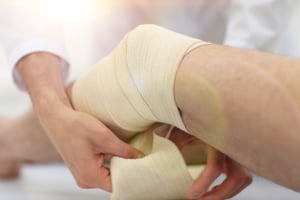 Hyperbaric oxygen therapy (HBOT) has taken wound healing to new, unsurpassed levels. Due to a number of different causes, many patients suffer from slow or non-healing wounds. In such cases, typical treatments, including ointments, medications, and bandages, may not be enough. This is when HBOT proves to be especially useful.
Hyperbaric oxygen therapy (HBOT) has taken wound healing to new, unsurpassed levels. Due to a number of different causes, many patients suffer from slow or non-healing wounds. In such cases, typical treatments, including ointments, medications, and bandages, may not be enough. This is when HBOT proves to be especially useful.
What is Hyperbaric Oxygen Therapy?
HBOT is a treatment option which involves the delivery of 100% pure oxygen in a controlled chamber. Typically, oxygen is delivered throughout the body by only our red blood cells. With HBOT, oxygen reaches all of the body’s fluids, allowing it to be circulated to anywhere in the body, including damaged tissue where normal blood circulation may be lessened or blocked. This increase in oxygen throughout the body promotes the ability of white blood cells to eliminate bacteria. The process is completely painless and non-invasive.
Hyperbaric Oxygen Therapy for Non-healing Wounds
Any type of wound or infection that has been classified as “non-healing” may benefit from treatment with hyperbaric oxygen therapy. In most cases, this classification is reached when a wound has shown no improvement for four weeks. Regardless of the cause, these wounds should be evaluated by a wound care and HBOT specialist.
Hyperbaric Oxygen Therapy for Diabetes-Related Wounds
What may be a harmless wound to an otherwise healthy patient can be far more complicated for one with diabetes. Being diabetic comes with a host of other potential complications, some of which make wound healing more difficult. For instance, narrow arteries may make circulation of blood to the wound more difficult, or a weakened immune system may hamper healing. Any wound in a diabetic patient should be treated carefully and watchfully.
Foot wounds are particularly bothersome for those with diabetes. These injuries are more prone to swelling and cannot be immobilized to allow for healing in the same way that other areas can. Furthermore, issues that are common among diabetics such as nerve damage and calluses make the feet even more prone to injury than those of an average patient. When these wounds present a serious problem and are slow- or non-healing, hyperbaric oxygen therapy can be a viable choice.
Hyperbaric Oxygen Therapy for Radiation Wounds
About half of all patients diagnosed with cancer will have radiation therapy included in their course of treatment. However, while radiation is used in an attempt to shrink or eradicate cancerous cells, the surrounding skin and tissue can be damaged. In fact, up to 95 percent of all radiation therapy recipients will develop a skin reaction, known as radiation dermatitis, to some degree. Based on the dose of radiation, beam used, and amount of time the skin is exposed, these injuries can involve the skin, underlying tissues, and even structures as deep as bone.
Treatment protocol for wounds resulting from radiation is based on a multitude of factors regarding the patient, their health, and the severity of the wound. In some cases, prescription ointments or special wound dressings may be enough to allow the skin to fully recover. However, in the case of more severe or non-healing wounds, hyperbaric oxygen therapy may be needed.
To learn more about the HBOT process and other types of wounds it is able to treat, click the image below to access our free patient guide.



.png?width=110&height=110&name=lane%20badge%20(1).png)
